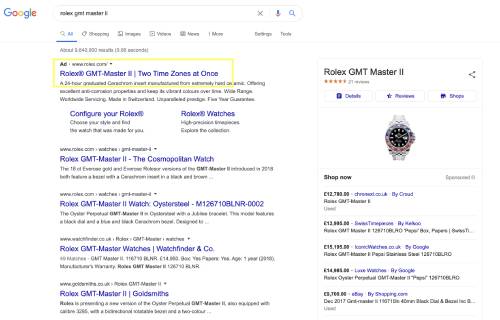Google Ads’ dynamic keyword advertising is based on Google’s algorithm indexing the content of a site and being able to match the content to search engine searches. Thus, ad format is a kind of intermediate form between keyword advertising and organic search results, where targeting and ad creation are largely automatic, but clicks are paid for and compete for visibility in the ad auction. The actual ad is also semi-automated and semi-manually generated.
Properly done, it is difficult to distinguish a dynamic ad from a regular search ad. One of the few clues is that the product offered in the ad title exactly matches the search, but other ad text is generic, like rolex GMT’s ad in the example below.

Another way to identify a dynamic search ad from a traditional one is to compare the ad title to an organic search result. If they’re similar, it’s likely that it’s a dynamic ad.
The benefits of a dynamic ad format are efficiency , scalability, and relevancy . We save time and effort when we don’t have to create our own advertising for each product and search. Dynamic advertising can also be a great place to start doing keyword advertising, as creating a dynamic ad is quick and you can even include all the pages of your entire site. Advertising is also very relevant because Google’s algorithm selects the best and most accurate landing page for a search on a site.
Dynamic advertising is the easiest way to incorporate any company’s products or services into advertising, cost-effectively. I myself prefer dynamic advertising for precisely these reasons. For the same reason, I have also over the years made numerous bugs and have encountered many challenges with the dynamic keyword ads. Here are my biggest challenges to the success of dynamic keyword advertising.
1. The site does not have enough textual content
If the site has no textual content, dynamic keyword advertising will not work, because then Google has nothing to match search engine searches to the site. At this point, with dynamic advertising, it usually happens that the ads get little impressions. For this reason, dynamic advertising works best when there is enough content for site development and the company and product being sold.
2. The url structure of the site does not support dynamic advertising
With dynamic keyword advertising, it’s possible to limit your advertising to just a portion of your site, and one way is to use a url. The most reliable way to narrow down the dynamic advertising field is to select only those parts of the site where you can find the products or services to be advertised, for example / products /, / category / or / services /. However, if the structure of the site is not clearly structured, but the url structure is a bit how it hurts, this may be difficult or even impossible.
3. The site is not updated often enough
Dynamic advertising can easily become a money hole if the site is not updated actively enough and obsolete pages are not removed from the site. This is a problem that I have encountered in the end sold online shopping products, but also service organizations, where such. Expert site has not been removed former employees. It is possible to exclude such pages if, for example, the page indicates that the product is sold out, but the most accurate way is to remove the pages completely. If outdated pages remain alive on a site, it’s possible that your marketing budget will be wasted and the customer experience will suffer when an applicant who enters the site through an ad doesn’t find what they’re looking for and is likely to leave the site.
4. The site has a variety of content
Dynamic advertising can also become more difficult if you find a lot of different content on your site. Customer stories, case demonstrations, product installation guides, and news can inadvertently end up in the realm of advertising and get “interesting” ads in their time. This becomes especially a problem if the url structure of the site is incomplete, because then it may be impossible to limit the advertising to product or service pages. An example of one’s own history was when an insurance company’s advertisement began to gather evidence with “sählymaila” searches, when the types of accidents covered by the insurance had been opened in connection with the insurance product.
5. Site titles are not optimized
Google will pick up the title of the landing page as the title of the ad. This is a good thing when the titles are clear, descriptive and selling, but a worse thing if the site’s titles are a bit of what hurts.
In summary, dynamic keyword advertising is most effective when the site is search engine friendly and actively maintained. Dynamic search advertising also requires monitoring and development to identify and address the issues mentioned above. Is the power of your digital advertising wondering? Contact us and we will help!
Keywords
- Google Ads
- Google AdWords
- Advertising
